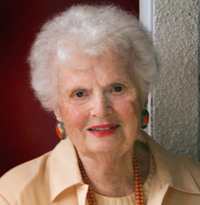By Natasha Josefowitz, ACSW, Ph.D.

About 25 years ago, Dr. Cliff Colwell replaced my right hip. The operation was successful; it has never bothered me since. However, at the time of the procedure, he advised me that my left hip had osteoarthritis and would also need a replacement soon.
Twenty-five years later, I was standing in the sales office of White Sands, the retirement community where I live, with a couple. The man looked vaguely familiar; he was also looking at me quizzically. I was introduced to Dr. Cliff Colwell and his wife, Carolyn. I exclaimed, “Oh my goodness, I am Natasha.” He remembered me because he had written a forward to a column on my hip replacement called “Hip Hip Hooray.”
We hugged. I told him that he had been wrong about my left hip, which had never bothered me. He admitted that he had been wrong a few times in his life. After that, Cliff, Carolyn and I became good friends; we would share many meals together.
A few months ago, my left hip began to hurt. I called Cliff and said, “Congratulations. You are finally right. My left hip is hurting.” The problem is that I am 96 years old and a major operation at my age is risky due to the frailty of advancing years. As the weeks have gone by, my pain has increased. I was now limping and using a cane. Cliff suggested a cortisone injection. I called Scripps Clinic. The first available appointment was two weeks away.
My pain was reaching a level eight, even nine; it was becoming excruciating! I shared this with Cliff, who told me he would take care of it. Within minutes I received a phone call from a Scripps scheduler. I had an appointment scheduled for the next day at 7 am. My trusted limo service, A Best, would pick me up at 6:30 am. Kosta, the Greek owner, was there early. (I must admit — I was nervous.)
We arrived at the clinic. Kosta got a wheelchair and pushed me to the orthopedic department, where large gold letters displayed on the wall read “The Colwell Orthopedic Institute.” No wonder I could get an appointment early!
I was wheeled to a cubicle to see Dr. Hai-Yan Li. Dr. Li is one of twenty PAs (physician’s assistants) at the institute. Their staff also includes twenty orthopedic surgeons. After her examination, Dr. Li told me I had two choices: I could get a cortisone shot right now or wait until the next day, when she could inject under fluoroscopy, providing a one-hundred percent assurance of hitting the right spot. There was no such assurance if she gave me the shot now. I agreed to wait.
The next morning, again at 6:30 am. Kosta was there to take me back to the clinic. This time we went straight to the operating room, where three nurses helped me onto the examination table. My hip was uncovered right above the groin. An anesthetic was injected. After a few mild pin pricks, I asked: “When are you giving me the shot?” “It’s already been done,” was the answer. I didn’t feel anything.
Kosta was in the waiting room with a wheelchair ready to take me home. He wheeled me to my apartment. I call him my new caretaker. I was told to reduce my activities to fifty percent for the next few days. Now I have the excuse to stay in my recliner doing my favorite activities: reading and writing. I needed to monitor my pain level hourly the first day, then daily for two weeks until my follow-up visit with Dr. Li.
Much to my relief, I felt almost no pain that night – maybe a level two or three at best. The next day the pain was minimal. At times when I walked it did not hurt at all. I was in awe of modern medicine!
When I had my hip replaced twenty-five years ago, the operation took one and a half hours with general anesthesia followed by bed rest for several days. Today it is an outpatient procedure that takes forty-five minutes using a local spinal epidural, with a rate of infection at less than half a point, and pain relief in the high nineties percentile.
In 1985, Dr. Cliff Colwell was the principal investigator using stem cells injected into the hip with a local anesthetic. One of the ultimate goals was to replace worn cartilage with living tissues rather than metals and plastics. They are presently growing five different stem cell lines to first test success in animal models before applying this technology to humans. The future looks bright for hip replacements.
*
© Natasha Josefowitz. This article appeared initially in the La Jolla Village News. You may comment to natasha.josefowitz@sdjewishworld.com